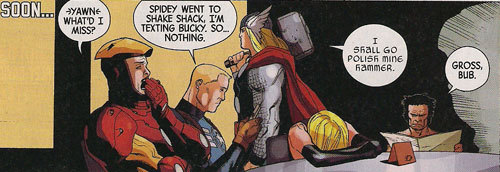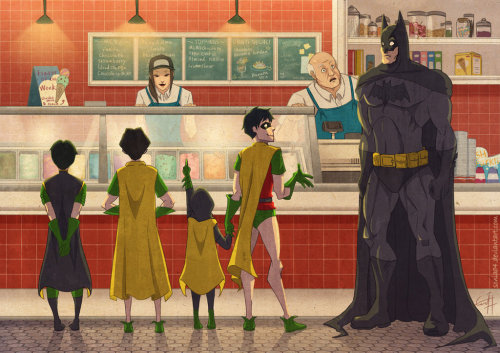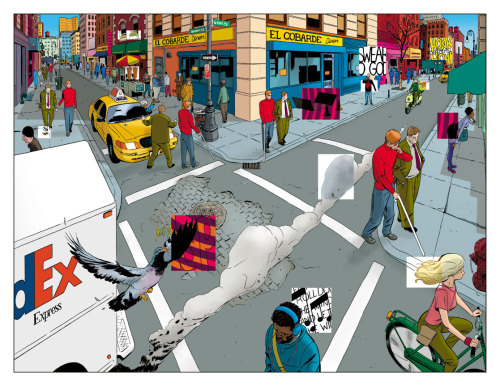
Celebrating the best of the year….Hit the break.
THE TOP 10 PREDICTABLY GREAT COMICS OF 2011
Let’s start with some standards: Ongoing, regular books that have been going on for over a year, and represent some of the best comics in the business.
10. S.H.I.E.L.D. It’s heady and hard to follow, but the art and writing are terrific.
9. The Amazing Spider-Man. A few missteps this year, but generally one of the best superhero books on the market with adventurous art and masterful storytelling.
8. Avengers Academy. I raved about this month in and month out, and if you’re not reading it, you’re an idiot.
7. X Factor. Year in and year out, a completely dependable workhorse of a book.
6. X-Force. This year, someone made me give a shit about Apocalypse. That man is Rick Remender.
5. The Walking Dead. A friend once asked me why I still read this, since every story arc is pretty much the same. I responded: Why do you still eat ice cream? Every time, it’s pretty much the same.
4. Secret Six. Now cancelled. (Sobs.)
3. Sweet Tooth. One of the only truly haunting comic books on the market.
2. DeadpoolMAX. I love this book. Love it!

1. Batman.
Scott Snyder was hitting it out of the park before the renumbering, and he kept it up post-new-numbering. This isn’t listed as a “best reboot,” with the other new 52s mentioned below, because we’ve all been assured that all the pre-52 Morrison stuff is canon, and nothing other than that pre-52 stuff mattered anyway.
Hit the break for more best of stuff….
BEST EVENT OF THE YEAR: SCHISM

Flashpoint was boring. Fear Itself had a good issue #0 and a decent conclusion, but the middle was terrible and then it got drawn out by a follow-up series. The New 52 isn’t really a single event—it was much bigger than that. No, one mini-series slipped in kind of under the New 52 hype and proved that “important” “event” books can be fun and can matter, all at the same time: X-Men Schism. Great comic book stuff that was fully accessible to anyone who had even a passing knowledge of the X-verse. Yeah, there was a bit of filler—and the book didn’t have all that much story to it—but it looked great. Jason Aaron is one of those writers who I’m hot and cold on. Much of his stuff seems adequate but not stellar (Wolverine, Ghost Rider, and his “Astonishing” work) but then occasionally he hits it out of the park (PunisherMAX, Black Panther, and sometimes Scalped). This one was somewhere between those two poles, but as an event (as opposed to a story arc) it rocked harder than most.
And while we’re talking big things….
THE TOP 5 OMNIBI OF 2011
5. X-Statix Omnibus by Peter Milligan and Mike Allred, among others. This is technically not released yet, but I know many (most) of you missed out on the psychedelic oddness that was Peter Milligan and Mike Allred’s mutant book, which included characters with super-bodily functions and bizarre names like U-Go Girl, Doop, and Venus Dee Milo. Collects the team’s X-Force run from 1991, as well as all the X-Statix books and crossover stuff.
4. Walt Simonson’s Thor Omnibus. I said a lot about this book here, so I don’t think more need be said. One of the greatest—albeit wordiest—non-Stan-Lee runs in comic book history.
3. The Fantastic Four Omnibus by John Byrne. Reed Richards saves Galactus’ life, and is brought up on intergalactic homicide charges for it! The Thing turns from rocks to mush! Franklin Richards grows up and becomes a child again, all in one story! The introduction of Herbie the Robot! Galactus gets a new herald! Marvel’s first all widescreen issue, probably inspired by Dave Sim’s classic “High Society” run on Cerebus! This, and much more. Absolutely….Fantastic.
2. The Definitive Irredeemable, vol. 1 by Mark Waid and Peter Krause. The first eleven Issues of the BOOM! Studios book about a Superman who becomes a very, very bad man. A great story, but a dark one: Not for the kiddies.
1. The New Teen Titans Omnibus by Marv Wolfman and George Perez. From their first appearance up to just before Terra joins the band, this collects the first 20 issues of The Most Important And Influential Team Book of the 1980s. A must read. Can’t wait for volume 2.
THE TOP 10 NEW, NEWISH OR REBOOTED COMIC BOOKS OF 2011
In a year in which DC launched more than 52 new series, it’s hard to limit the list of the best new comics of 2011. But I did my best….Before the big 10, I think two honorable mentions are in order. First, for Grant Morrison and Rags Morales on Action Comics. Putting the overused joke aside (“I own Action Comics #1!), Morrison’s reboot of the first superhero of all time started with a whimper but continued with a bang. And another bang. A new power set, a less idealistic point of view, and the attitude of a teenager, Superman/Clark Kent is interesting again not just as a hero, but as a character. So far, they haven’t knocked me out with this, but I can tell it’s a slow build and worth watching. My other honorable mention goes to mark Millar’s Superior. I love this comic—it’s popcorn superheroics as they oughtta be done.
10. Neonomicon by Alan Moore and Jacen Burrows [NEWISH]
Nobody can write horror comics like Alan Moore, and nobody can draw depravity like Jacen Burrows. It took forever for the final issue to come out (a four issue book that started in July 2010 and didn’t end until February 2011), but it finally arrived and, frankly, it reads better in bound form anyway. Not for the squeamish, the book is a sequel to the same team’s 2005 book “The Courtyard.” It builds on mythology created by HP Lovecraft and tells a story of a twisted cult that worships a rapist demon and…I can’t explain it. Just trust me, it’s fucking amazing
9. Morning Glories by Nick Spencer and Joe Eisma [NEWISH]
Launched in August 2010, this is the “least new” book on this list, but it warrants mention on this main list because it was this year that it really picked up steam and rocketed ahead. About a (haunted?) boarding school and some (mutant?) special students, Morning Glories mixes elements of horror and soap opera to create a story that’s frightening as hell, sexy, and constantly suspenseful. It’s like Lost in the way it keeps drawing out the mysteries, but unlike Lost, I’m confident that Nick Spencer has the denouement all figured out.
8. Venom by Rick Remender [NEW

This book is not without its faults, but the idea that someone could turn Venom from a punchline (which is basically what Marvel had allowed the character to become) into a completely different, completely surprising character was previously unthinkable. And the idea that Marvel could do the same thing for the C-list character of Flash Thompson? Wow. Rick Remender truly outdid himself here, creating a very cool superhero spy book that was so, so, SO! much better than the Secret Avengers. Which, by the way, is a book Remender is taking over. And it wouldn’t surprise me a bit if Venom is on the new team roster. Although for my money, it’s Tony Moore who should be on permanent art chores for this book. The main weakness with the book is the lack of a consistent artistic voice. I think the Remender/Moore thing is just special to me, ever since their collaboration on the underrated Exterminators series for Vertigo.
7. PunisherMAX by Jason Aaron and Steve Dillon [NEWISH]
Early in this year’s crop of PunisherMAX, Jason Aaron finally hit his stride. The Bullseye and Kingpin arcs were fun and cool, but Aaron still hadn’t found a voice that made me forget Garth Ennis. But with the Punisher-in-jail arc, he did. Six comics that span about 48 hours of real time, the story folded in the Ennis background about what Frank Castle did in Vietnam, but he also went even earlier. And rather than jump right to the murder of Castle’s wife and kids, Aaron focused on Castle’s difficult transition from combat Marine to civilian. These flashbacks were used to parallel not a villain or side character, as is so often done, but rather were set against Punisher’s story in jail, to show how Castle and Punisher—two sides of the same coin—would go through the same metamorphosis. Punisher has always been an antihero, but now he’s just plain scary: He’s a man who should be behind bars, and yet, by the inevitable prison-break ending, the reader was happy to see him free. And Dillon’s art, which has never really clicked for me, finally made sense. I’ve always thought him too sterile, but for this story he did fantastic work showing the age and weariness in Punisher’s eyes, as compared to those of Frank Castle several years earlier, before the murder of his family. A truly excellent book that, for reasons I can’t fathom, nobody seems to be talking about
6. Butcher Baker the Righteous Maker by Joe Casey & Mike Huddleston [NEW]
Image produced one of the oddest antihero books I’ve ever read. The plot is pretty simple: Aged American hero with a star-spangled costume is now retired, but he comes back for one more mission: To blow up the prison holding all of his arch-enemies. He does it, some escape, and violence and frenzy ensue. You’ve seen this kind of thing before: Destroyer, R.E.D., Blade Runner, Unforgiven…The list is endless. Why is it unusual? I’m not sure even where to begin, so I’ll just scattershoot a list of oddities: Baker’s “retirement” is something out of Garth Ennis—he’s having continual sex with three women (he has a very brief post-coital “refractory” period)—and he’s lured out of retirement by Dick Cheney who offers him three more women. One of his enemies is a bubble-bod woman…with a penis. Oh, and it’s full of profanity. Not just curses, mind you, but profanity: Words that take sacred ideas and twist them and mangle them into something different.
Through it all, Baker is pursued by a highway patrolman (much of the first three issues is a long car chase—something you don’t usually see in comic books), and the reader starts to see that Baker is actually the bad guy.
And bad guys are smart, philosophical…Almost…Good guys?
Butcher Baker doesn’t have a long page count, but each issue took me quite some time to read. Partly because the words are complex, even if they’re not dense.
But it also takes time to get through each issue because the art is somewhat abstract. It’s beautiful, it’s scary, it’s gross, and it’s interpretive. Baker’s truck, driving fast, turns into a blur of spot-color and motion lines. The girl with a penis has not flesh or clothes but a universe inside her body lines. And people look like “real people.” We see Reagan, Burt Reynolds, Jay Leno, and others making appearances, seemingly randomly but always with a purpose.
And perhaps even more interesting than the comic (no, not really, but close) are Casey’s essays that appear at the end of each issue on the state of comic books. Here’s the guy who was a major part of shaping the Marvel character Cable and who had a long stint on Superman blasting capes as commerce not art, saying that only indie comics actually “create.” I completely disagree with him, of course. Reconstituting something fresh from existing materials is the very definition of many forms of art, and saying something new about something old is the foundation of satire. But I take his point, and it’s very interesting.
5. The Green River Killer by Jeff Jensen and Jonathan Case [NEW]

An original graphic novel published by Dark Horse and written by the son of Detective Jensen, who ultimately cracked the true-life case of the Green River Killer, this part-biography/part true-crime story is an example of how comic books can be used as a medium that educates and examines, rather than simply entertains. Of course, the story alone is chilling—but accentuated by the powerful simplicity of black-and-white line drawings, it is deeply affecting. The book offers what feels like an authentic look at the pain and frustrations of a Detective, grinding day after day, sharing a house with serial killer whose fading memory is more a tool for emotional distance than a stalling technique.
4. Batman, Inc., by Grant Morrison [NEWISH]
What made this one so much fun was how it really was a series of done-in-ones (or twos), each with a very different style of storytelling (but all written by Grant Morrison) as well as art (different artists), and how it tied so much “fringe-y” Batstuff into a single story. It was the perfect disjointed follow up to the disjointed “Return of Bruce Wayne” series that preceded it. And the promise of a future conclusion to it all in 2012 has me on the edge of my seat. I just wish it wasn’t on hiatus.
3. Swamp Thing by Scott Snyder and Yanick Paquette [REBOOT and NEW]
There hasn’t been a mainstream DC Swamp Thing title in many years, and there hasn’t been an excellent Swamp Thing since Alan Moore. Scott Snyder’s handling pays tribute, every issue, the ideas that came out of Moore’s seminal run with this character, but also appears to have a direction of its own. It remains to be seen whether the book will surpass its progenitor, but for now I can say, without a doubt, that it ain’t making me miss Alan Moore. And that’s a damn good start.
2. Daredevil by Mark Waid and (usually) Marcos Martin and/or Paolo Rivera [REBOOT]
Not be outdone by DC, Marvel relaunched three characters this year—all prior to the new 52: Moon Knight, Punisher, and Daredevil. All three are good, but one is great. And only that one—Daredevil—represents a true reimagining of the main character. This is Daredevil like you’ve never seen him before (or at least like you haven’t seen him since the first issues of his book, over 30 years ago). It’s a visual comic that experiments with novel ways to express DD’s blindness. It’s about a character who descended into darkness for decades at the hands of some of the best creators in the business (Miller, Bendis, Brubaker, Nocenti…) and yet it’s lighthearted at its core. It has lots of “secret identity” stuff, even though Murdock’s identity isn’t really a secret anymore. This is a wonderfully mature approach by one of the best craftsmen in the business, and a great reboot.
1. Joe the Barbarian by Grant Morrison and Sean Murphy [NEW]
Probably one of my favorite comic books of all time. Seriously. This is comics-as-literature, with tremendous art, a sophisticated story, and readability at several levels for several age groups. Plus: Transformers, G.I. Joe, Batman, Care Bears and Star Trek in one book! The story is simple: Diabetic boy gets his candy bar taken by bullies, and now needs a can of soda or he will slip into a coma. Through his dropping blood sugar level delusion, the boy reimagines himself a hero (“Joe the Barbarian”) on a quest to save the world, and his staggering stumble to the kitchen is paralleled in the adventures of his alter-ego. Sure, there have been stories like this before, but never, ever, have they been this powerful, this compelling, this well-drawn…A home run that deserves a spot on your bookshelf, and a great example to show teachers at schools of how reading comic books is not the equivalent to reading junk but can actually be as deep, powerful, and enriching as reading “real” books. Especially the crap they’re requiring my kids to read in public school these days. I’ve ordered three copies to give away, and plan to get even more.
HONORABLE MENTION: Daybreak by Brian Ralph. A fresh take on the zombie genre, in which the reader is personally involved in the story. Don’t be put off by the child-like drawings–there’s a heaviness beneath the innocence.


